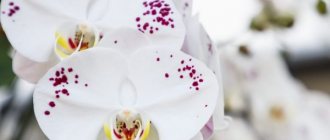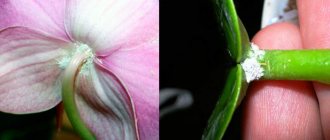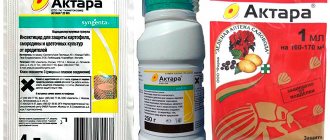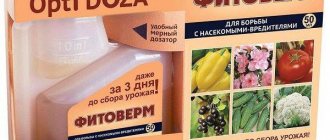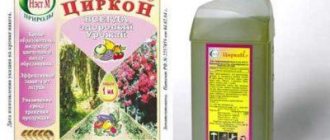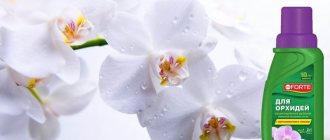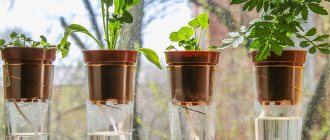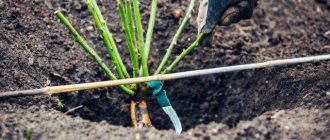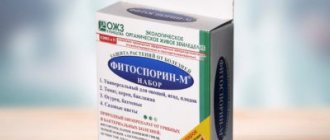Home / Preparations and fertilizers
Back
Published: 06/18/2019
0
3.9/5 — (19 votes)
Aktara is one of the most popular and widespread insecticides among gardeners and gardeners. A wide range of applications and proven effectiveness against most pests are the undoubted advantages of the drug. Like any chemical, Aktara has limitations that should be considered before use.
- 1 Composition and principle of action
- 2 Scope of application
- 3 Advantages and disadvantages
- 4 Release forms
- 5 Security measures
- 6 How to prepare a solution
- 7 Use for different types of crops
- 8 Processing of seedlings
- 9 Compatibility of Aktar with other drugs
- 10 Actions in case of poisoning
- 11 Reviews
Composition and principle of action
The active ingredient of the drug is thiamethoxam. In small doses, the synthetic compound causes stimulation of the nervous system of pests. Significant concentration leads to paralysis. Aktara belongs to the group of contact-intestinal insecticides. The substance is absorbed into the plant tissue, along with the cell sap enters the gastrointestinal tract of the insect and provokes its death. Pests with thin cover die after contact with the drug. Actara's effect does not apply to eggs, pupae and larvae.
The insecticide is used in 2 ways: spraying the ground parts of garden, vegetable and indoor crops and watering at the roots. In the first case, the solution is absorbed by the shoots in a matter of minutes. When applied to the soil, it takes several hours for the active substance to be distributed throughout all the vascular tissues of the plant. For fruit trees, this time is on average 1-3 days; for low-growing crops, 2-3 hours are enough.
Thiamethoxam mainly accumulates in plant leaves; its concentration in fruits is insignificant. The protective function of the drug lasts for 2-3 weeks after foliar treatment and 2.5-3 months after watering the soil.
Purpose of the product
This insecticide belongs to the group of neonicotinoids and effectively fights the following pests in the garden:
- Colorado potato beetle;
- wireworm;
- thrips;
- aphids;
- psyllid;
- whiteflies;
- leafhoppers;
- flower beetles;
- copperhead;
- spider mite;
- plant mites;
- Diptera miners;
- scale insects;
- false scale insects.
This drug is also capable of suppressing lepidopteran pests, but is not very effective against them.
How to distinguish the original Aktara from a fake
Aktara can be used to treat plants over large areas and in private farms.
Scope of application
The insecticide packaging shows a close-up picture of the Colorado potato beetle, a well-known enemy of potato beds. Despite this, the spectrum of action of the chemical is much wider. Aktara is used in the fight against aphids, whiteflies, thrips, scale insects and many other harmful insects. The effectiveness of protection against onion flies, cabbage flea beetles, and apple moths has been proven. Dangerous pests are controlled in several ways:
- spraying over the entire surface of the above-ground parts of plants;
- application to the soil in beds and in bowls with potted plants;
- soaking the roots of vegetable seedlings;
- treatment of tubers before planting in the ground.
Advantages and disadvantages
The insecticide is deservedly popular among gardeners. Aktara's strengths include:
- The speed with which the drug affects pests. Insects eat poisoned leaves and receive a lethal dose of a toxic substance, which within half an hour provokes paralysis, subsequently leading to death.
- Effective against a wide group of pests, including insects that parasitize the back side of foliage.
- Absence of the unpleasant odor characteristic of most insecticides in dissolved form. For this reason, Aktar can be used in residential areas to treat indoor plants.
- Weather resistant. Efficiency does not decrease in heat and under the influence of ultraviolet radiation. After absorption, the drug is not washed off by precipitation.
- Safety for humans if precautions are taken.
- Toxic substances are not concentrated in the fruits of treated crops; therefore, hygienic safety is not compromised.
- Compatibility with other drugs aimed at protecting against harmful insects, fungal diseases, stimulating plant growth.
Release forms
The development of the drug belongs to the Swiss company Syngenta. In the Russian Federation, Aktara is produced under license. There are several forms of release on sale:
- water-dispersible granules (WDG) packaged in 1.4 g, 4 g and 250 g;
- liquid suspension in ampoules of 1.2 ml and polymer bottles of 9 ml and 1 l.
As a rule, one package of the minimum quantity is enough for processing garden and vegetable beds on individual farms and for use at home to protect indoor flowers. Large packaging is intended for the use of insecticide on an industrial scale.
Stable demand and high cost of Aktara have given rise to a market for counterfeit drugs. To protect yourself from unscrupulous manufacturers, you should know the characteristic features of the original drug:
- the hologram applied to the packaging has a denser structure and is completely separated from the surface;
- the Syngenta logo is visible in the center of the hologram; if you change the viewing angle, the Aktara inscription appears;
- The original packaging contains state registration numbers and container labels (for those licensed in the Russian Federation).
In Russia you can purchase registered analogues of the insecticide, which also contain thiamethoxam: Tiara, Eforia, Doctor Cruiser and Adamant.
The shelf life of granules is 4 years, ampoules - 12 months. The chemical is stored in a sealed condition at a temperature range of 10°C to 35°C, out of the reach of children and pets.
Storage
The drug must be stored in a dry, dark place at a temperature of -15—+30 degrees Celsius. Aktara should be kept away from food and medicines and out of the reach of children and animals.
Indoor flowers, as well as cultivated plants grown in a summer cottage, need preparations that could effectively fight pests and would also be useful for the pets themselves. One of these products is “Aktara” for indoor plants. What are the advantages of this insecticide, why it is the most effective - this and much more will be discussed below.
Security measures
Aktara belongs to low-toxic drugs of class 3 hazard for humans and mammals. To completely eliminate the risk of poisoning and burns, you must strictly adhere to the instructions and follow certain technology:
- when working with the substance, use gloves, a mask or a special respirator;
- manipulations with the insecticide are carried out in an open space; when working in a living room, a window is opened;
- refrain from drinking water, food and smoking at the time of contact with the drug;
- after use, burn the container of the used solution;
- After finishing all the work, wash your hands thoroughly and rinse your face.
How to prepare the solution
Aktara is easily soluble in water, but to prepare a working solution from dry granules, some nuances should be taken into account:
- pre-prepare containers for mixing the required volume and check the serviceability of the sprayer;
- the prepared solution cannot be stored, so the required amount of granules is immediately measured, which depends on the crop being treated;
- the contents of the package are diluted in a small amount of water (temperature not lower than 25 °C);
- shake thoroughly until the liquid structure is homogeneous;
- add the solution to the required volume, mix again;
- Liquid Aktara in ampoules is prepared according to a similar principle.
After these manipulations, the drug is ready for use. Plants should be sprayed in cloudy (but not rainy) weather. When the need to treat against a pest does not allow you to hesitate, and there is a likelihood of precipitation, you should spray the plants no later than an hour before the rain. On sunny days, early morning or after sunset is suitable for processing.
Use for various types of crops
The standard bag contains brief instructions for using Aktara for plant protection. The concentration varies depending on the specific crop and type of treatment.
| Culture | Pest | Drug consumption |
| Potato | Colorado beetle | 1.2 g per 10 liters of water. Spray once. Waiting period 14 days |
| Currant | Aphid | 2 g per 10 liters of water. Spray before flowers appear, re-spray after harvest |
| Tomatoes, eggplants, sweet peppers | Aphids, Colorado potato beetles, whiteflies, leafhoppers | 1.4 g per 10 liters of water. Spray once after an attack by pests 4 g per 10 liters of water for application to the soil |
| Cabbage | Aphids, flies and flea beetles | 3 g per 10 liters of water. One-time spraying. Waiting period 3 weeks |
| cucumbers | Aphids, whiteflies, tobacco thrips | 2 g per 10 liters of water. Spray once until buds appear. 8 g per 10 l for application to the soil |
| Grape | Cicadas | 3 g per 10 liters of water. Single spraying |
| Apple tree | Codling moth, aphid, copperhead | 3 g per 10 liters of water. Spray once before or after flowering. |
| Fruit trees | Aphids, codling moths, honey moths, scale insects | 4 g per 10 liters of water. Spray once before or after flowering. |
| Potted crops | Aphids, scale insects, whiteflies, flies, false scale insects | 1 g per 10 liters of water. Spraying in case of pest attack. 0.8 g per 1 l. Application into the soil after moistening the soil. |
Helpful information! If the bag contains more drug than is required for a single treatment, the granules are poured onto a paper sheet and divided into equal portions using a toothpick. The required amount is used for further preparation. The remaining “piles” are poured into plastic bags with an airtight closure.
Processing of seedlings
Aktars are often used to treat potato tubers before planting in open ground and for preventive treatment of seedlings. The procedure is carried out before planting seedlings in a permanent place. The procedure is as follows:
- 1.4 g of Aktar granules are dissolved in 1 liter of warm water;
- seedlings of tomatoes, peppers, eggplant are soaked in the solution for 2 hours so that the roots of the seedlings are evenly wetted with the liquid;
- no later than 12 hours after treatment, the plants are planted in the ground.
To process potato tubers, use 6 g of granules diluted in 0.5 liters of water. The planting material is laid out on polyethylene and sprayed with the resulting solution using a spray bottle. Wet tubers are mixed to evenly distribute the substance and immediately planted in the beds. Potatoes processed in this way are not stored.
How to treat violets against midges?
Spraying with a weak solution of potassium permanganate, add 0.3-0.5 g of powder to a liter jar of water; After watering with soapy water, dissolve 1/3 of a piece of laundry soap in a liter of water; Treating violets with garlic infusion: pour boiling water over 3 heads of garlic and let it brew.
Interesting materials:
Who approves the staffing table of an educational institution? Who approves the staffing schedule of an educational organization? Who approves the composition of the commission to investigate a group accident during the operation of a production facility controlled by Rostechnadzor? Who is in the European Union? Who maintains the executive documentation? Who maintains a personal record card for issuing PPE? Who maintains the register of shareholders in the CJSC? Who are the officials? Who is on the minor accident investigation committee? Who is included in the mot?
Compatibility of Aktar with other drugs
One of the advantages of Aktara is that the drug can be used in combination with most herbicides, pesticides, and growth stimulants. This property allows the insecticide to be used in tank mixtures. Gardeners combine Aktara with Fitosporin M, Epin and Zircon. Before use, it is advisable to conduct a compatibility test of the active ingredients. To do this, mix a small amount of drugs and observe the consistency of the resulting solution. If sediment appears at the bottom, there is no practical point in using the mixture.
Rules for using insecticide
Aktara is suitable for use throughout the growing season without changing its properties, regardless of the level of humidity and weather conditions. Among other things, the drug can be combined with many other means without having a detrimental effect on the plants themselves, animals and, of course, humans who are forced to constantly contact the treated plants.
Indications for treatment
The insecticide should be used only when whiteflies, aphids, thrips, spider mites, bedbugs, earth flies, beetles (including Colorado potato beetles), all kinds of butterflies and caterpillars, flea beetles, leaf miners, scale insects, bread ground beetles, beetles and other pests.
The drug can be combined with many other drugs
The exception is mites, except for spider mites, since only acaricides in combination with the use of film have a sustainable effect against these dangerous pests, which literally suck all the juices out of plants.
Aktara works equally well both on the outer part of indoor, garden and vegetable plants, and when treating the root system of seedlings, soaking planting material, as well as spilling soil. In this case, the plants completely absorb toxic substances, becoming unsuitable for parasites, while over time these properties are neutralized, posing no threat to people and animals.
How to prepare the solution
Having made sure that the treatment is necessary, a new question arises - the correct dilution of the working solution and its use on the site or in the house. In this case, not only the dosage is of great importance, but also the consumption, and usually to spray one hundred square meters it takes at least 5 liters of water with 2 grams of the drug dissolved in them. That is, a 4-gram package is enough for 10 liters, which are used to process 2 acres.
Thus, the mother solution is initially performed, and only then the working solution, which allows for maximum dissolution of the drug. The process of preparing the solution consists of the following steps:
- A liter of water with the contents of one sachet of Aktara (4 g) is diluted in a 1.5-2 liter container. It is this highly concentrated solution that is called the mother liquor.
- The resulting mixture is poured into the sprayer container, after which the rest of the water is added, which makes it possible to obtain a working solution ready for direct use.
It is important to remember that the amount of water added directly depends on the type of crop being processed.
And in order not to get confused, experienced gardeners and gardeners recommend changing the dosage of the mother solution, only then adding water to the required volume of 5 liters.
Seed dressing
Some may be surprised, but Aktara is also used for treating planting material, and in fairly high concentrations. So, to soak seeds, bulbs and tubers of flowering and fruit and vegetable crops, you must use a solution prepared from a liter of water and one packet of insecticide.
Aktara is suitable for use throughout the growing season without changing its properties, regardless of humidity levels and weather conditions
If you need to process potatoes, then it makes sense to increase the concentration to 4 g per 300 ml of water. Moreover, any fears about high toxicity will be completely in vain, since the planting material is soaked in such a solution for only a few hours, completely freeing itself from harmful substances after 60 days.
How to use on seedlings
A similar composition of the solution is used to treat seedlings, another thing is that we are not talking about spraying, but soaking the rhizomes of seedlings grown for planting in open ground. The soaking procedure itself is carried out no longer than two hours, after which the plants are allowed to dry and planted in open ground after 10-12 hours.
At the same time, you should not rush to get rid of the remaining liquid, which can be diluted to a total volume of 10 liters and used for preventive or therapeutic watering of already planted plants.
Does the drug help against armyworms?
Since we are talking about a broad-spectrum systemic insecticide, it can also be used against fruit-gnawing cutworms, codling moths, leaf rollers and other dangerous insects. And the most effective in this case will be the ground application of the diluted drug, since the cutworm eats up the tubers and large rhizomes of young plants.
Security measures
According to the international classification, Aktara has a toxicity degree of III, being a moderately toxic treatment agent. And despite the relatively quick neutralization of its harmful substances, it is imperative to take precautions using special protective equipment in the form of glasses and gloves.
Be sure to take precautions
In addition, it is recommended to resort to spraying only in open areas. Also, Aktar should not be used during the flowering of cultivated crops, since the procedure can negatively affect the ovary.
Analogues and compatibility with other drugs
Today, in stores specializing in the sale of plants for the garden and vegetable garden, you can find a large number of universal preparations, among which there are many equivalent analogues of Aktara. Among them are Tiara, Adamant, Doctor, Cruiser and many other insecticidal agents.
Actions in case of poisoning
When working with the drug, it is necessary to avoid contact in every possible way with both granules and suspension, and with the working solution. Otherwise, you need to act immediately:
- if drops of the solution get on the skin, they must be thoroughly washed off with a detergent;
- If the chemical gets into your eyes, rinse with cool water for at least 5 minutes;
- If it enters the digestive system, you should take the absorbent and drink plenty of water.
Symptoms of insecticide poisoning include nausea, swelling of the eyelids, and dizziness. In this case, it is recommended to seek medical help.
First aid
The recommendations below are intended only for providing FIRST aid, after which you should immediately consult a doctor and follow his instructions! DO NOT SELF-medicate!
If you feel unwell while working, take immediate action:
- Potassium soap for plants is an excellent adhesive
- the victim should be taken out into fresh air when the first signs of poisoning appear: weakness, vomiting, nausea, malaise;
- if Aktara gets on the skin, you need to blot the drug with a cloth or cotton wool, being careful not to rub it, and then rinse the area with plenty of running water;
- if Aktara gets into your eyes, you need to rinse them open with a running stream for 15 minutes;
- if the drug was swallowed, but the victim is conscious, you need to give him to drink crushed 3-5 tablespoons of activated carbon with a glass of warm water and induce vomiting. Attention! Do not induce vomiting if the victim is unconscious. You need to urgently call a doctor and show him the drug label!
After providing first aid, you should immediately go to see a doctor! There is no antidote for Aktara, so treatment consists of controlling the symptoms. Your best bet would be to consult a poison control center.
